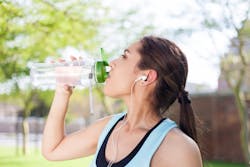Point of use (POU) water treatment systems are a hot topic. Because of the aging infrastructure of U.S. water distribution systems and the possibility of industrial spills or main breaks, water quality may become compromised. The final barrier for safe drinking water can be realized through cost-effective POU systems.
POU categories
POU systems are categorized into two groups: water filtration and water purification. Dealers and distributors must distinguish between these groups because consumers are often confused about the differences. The oldest type of purification, distillation, involves boiling water and then condensing the steam into a clean container. Distilled water is not a recommended choice for drinking water because the water is essentially "dead" water.
Many consumers prefer reverse osmosis (RO) water purification because of their concerns about contaminants. Both of these purification processes are devoid of minerals, and supplemental mineral intake through diet may be needed to maintain proper health.
During the last several years, many dealers have offered water purification systems with the added benefit of mineral and/or alkaline filters to replace important minerals and raise the pH of the water to an alkaline state. The jury is out on the benefits of these filters, but at least the consumer receives better quality water with the benefits of added minerals.
POU system benefits
The benefits of POU systems are vast and include:
- Addressing contaminants at the specific water-use level, providing a cost-effective method of treatment.
- Many POU system options are available to filter and treat everything water passes through, including showers and baths, washing machines, kitchen taps, ice machines, refrigerators, water and soda fountains, fish ponds, greenhouse irrigation systems, and dialysis and other medical procedures requiring high-purity water.
- POU systems can be manufactured to address all contaminants, thereby providing consumers with the protection they need, especially if their health is compromised.
- POU systems lessen the need for bottled water in the U.S., helping limit plastic pollution in waterways.
- Some concerns about cyanobacteria from algal blooms and the consequences from amoebic parasites have arisen. These microbes and pathogens can enter water supplies, and POU systems, such as RO and ultraviolet (UV) disinfection, can become inexpensive, final barrier illness preventers.
EPA definitions
The U.S. Environmental Protection Agency’s (EPA) Water Health Series: Filtration Facts provides the following small list of contaminants and suggests POU treatment methods:
- Giardia and Cryptosporidium — distillation, RO, absolute 1-micron filters, ultraviolet (UV) light or filters certified for cyst removal
- Bacteria and viruses — distillation, RO, UV light or disinfection
- Arsenic — adsorptive media
- Disinfection byproducts ― point of entry adsorptive media systems, distillation, aeration, carbon filtration or RO
- Lead — distillation, RO or some carbon filters
- Nitrates — distillation, RO or ion exchange
- Pesticides — some carbon filters
- Radium — ion exchange, distillation or RO
- Radon — activated carbon filter or aeration
POU systems for every treatment modality
Emerging technologies provide for constant upgrades to POU systems, and new treatment options have created a wider variety of options for contaminant removal. The choices are vast for consumers and include the following:
- Countertop water filtration systems may provide residential options without plumbing requirements or costs. Therefore, they provide water filtration for people who rent and do not have the authority to install into the plumbing system.
- Under-the-sink water filtration and purification systems offer flexibilities in treatment options and provide the consumer with cost-effective systems.
- Pitcher and refrigerator water filtration provide basic and affordable treatment.
- Portable water filtration offers protection for shower and bathing during traveling and outdoor activities.
Innovation and developing technologies
Using a proprietary, patented, electroadsorptive media technology, submicron filters can combine multiple treatment possibilities especially suited for all POU systems. These filters can reduce up to 99.99 percent of pathogens, heavy metals, volatile organic compounds and many inorganics. They employ this technology within a two-stage POU system that provides an alternative to higher-priced water purification.
POU products can be used to provide safe drinking water on the road. From micron water filtration bottles and pitchers to systems for disaster preparedness, these technologies can provide clean drinking water.
Collaborators including the Centers for Disease Control reported on the development and evaluation of a combined flocculent-disinfectant powder supplied in a small packet that is added to a 10-liter volume of household water by consumers. The powder contains coagulants and a timed-release form of chlorine.
After stirring briefly, contaminants settle to the bottom of the container and the supernatant water is poured through a cloth filter into another container for safe storage and use. Initial studies document dramatic reductions of microbial and some chemical contaminants in the water.
In addition, field epidemiological studies to determine reductions in household diarrheal disease are underway in Guatemalan villages. The cost of this treatment is estimated at $0.01 per liter.
Organizations make a difference
Several organizations today make a difference in the global fight for clean water. Organizations such as Rotary International, Water.org and Charity Water install POU water filtration systems in many rural areas throughout Latin America, Asia and Africa. Through these philanthropic efforts, more people now have access to clean, healthy drinking water at the local level, as opposed to villagers walking miles in search of a healthy drink.
Collectively help the world
POU systems remain the ultimate solution for water treatment throughout the world. With education and global efforts, distributors and dealers can continue to offer new and exciting POU products to a growing world population. Providing consumers with the fact-based information they need is critical so that they can make informed buying decisions about protecting their health.
Susan White is a freelance writer and marketing consultant for water treatment professionals. She has become knowledgeable from 11 years of experience and a passion to help consumers achieve healthier lifestyles through clean water. She advocates through online sources to consumers and commercial businesses. She may be reached at [email protected].


